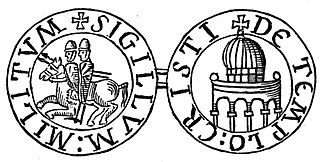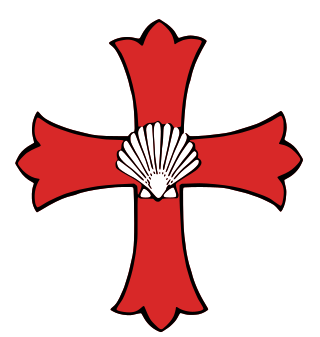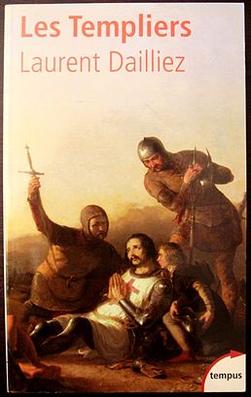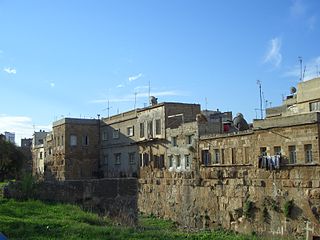
The Poor Fellow-Soldiers of Christ and of the Temple of Solomon, mainly known as the Knights Templar, was a military order of the Catholic faith, and one of the wealthiest and most popular military orders in Western Christianity. They were founded c. 1119, headquartered on the Temple Mount in Jerusalem, and existed for nearly two centuries during the Middle Ages. After their dissolution in 1312, several secret societies formed which eventually evolved into organizations such as the Freemasons and the Reconstituted Order of Christ

Jacques de Molay, also spelled "Molai", was the 23rd and last grand master of the Knights Templar, leading the order sometime before 20 April 1292 until it was dissolved by order of Pope Clement V in 1312. Though little is known of his actual life and deeds except for his last years as Grand Master, he is one of the best known Templars.

Hugues de Payens or Payns was the co-founder and first Grand Master of the Knights Templar. In association with Bernard of Clairvaux, he created the Latin Rule, the code of behavior for the Order.
Omne datum optimum was a papal bull issued by Pope Innocent II on 29 March 1139 that endorsed the Order of the Poor Knights of Christ and of the Temple of Solomon, in which the Templar Rule was officially approved, and papal protection given.

The Hospitallers of St Thomas of Canterbury at Acre, usually called the Knights of St Thomas was a Christian military order of the Catholic Church. Membership was restricted to Englishmen.

Ramon Berenguer IIIthe Great was the count of Barcelona, Girona, and Ausona from 1086, Besalú from 1111, Cerdanya from 1117, and count of Provence in the Holy Roman Empire, from 1112, all until his death in Barcelona in 1131. As Ramon Berenguer I, he was Count of Provence in right of his wife.

The Council of Vienne was the fifteenth ecumenical council of the Catholic Church and met between 1311 and 1312 in Vienne, France. One of its principal acts was to withdraw papal support for the Knights Templar at the instigation of Philip IV of France. The Council, unable to decide on a course of action, tabled the discussion. In March 1312 Philip arrived and pressured the Council and Clement to act. Clement passed papal bulls dissolving the Templar Order, confiscating their lands, and labeling them heretics.
Roger de Moulins was the eighth Grand Master of the Knights Hospitaller from 1177 until his death in 1187. He succeeded Jobert of Syria. His successors were two interim masters, William Borrel and then Armengol de Aspa, before the permanent Grand Master Garnier of Nablus was selected in 1190.

Everard des Barres was the third Grand Master of the Knights Templar from 1147 to 1152.

Bernard de Tramelay was the fourth Grand Master of the Knights Templar.

Guillaume de Beaujeu, aka William of Beaujeu was the 21st Grand Master of the Knights Templar, from 1273 until his death during the siege of Acre in 1291. He was the last Grand Master to preside in Palestine.

Guérin de Montaigu, also known as Garin de Montaigu or Pierre Guérin de Montaigu, was a nobleman from Auvergne, who became the fourteenth Grand Master of the Knights Hospitaller, serving from 1207–1228. He succeeded the Grand Master Geoffroy le Rat after his death in 1206, and was succeeded by Bertrand de Thessy.
Alain Demurger is a French historian, and a leading specialist of the history of the Knights Templar and the Crusades.

Laurent Dailliez was a French history doctor who graduated from Ecole pratique des hautes études. He was a researcher in medieval studies at the CNRS, a historian of the Crusades, and a specialist of the Knights Templar. Among other books, he wrote "Les Templiers". Dailliez was also the author of the article on the Templars in the leading French language encyclopedia, Encyclopedia Universalis.
Marie Luise Bulst-Thiele (1906–1992) was a German historian, known for writing about the Knights Templar. Her works are often cited by other medieval historians in their discussions of Templar historiography. In his own work Trial of the Templars, British historian Malcolm Barber discusses Bulst-Thiele's views on the Templars, as that she sees the attack on the Knights Templar as an integral element of the relations between the administration of King Philip IV of France and the Papacy.. With Walther Bulst she had four sons, among them Neithard Bulst, history professor in Bielefeld.
William of Malines was a Flemish priest who was the Prior of the Church of the Holy Sepulchre from 1127 to 1130 and was then Latin Patriarch of Jerusalem from 1130 until his death. He is sometimes called William I to distinguish him from William of Agen, second patriarch of that name, but he was the second William to serve as prior of the Holy Sepulchre after William the Englishman.

The fall of Ruad in 1302 was one of the culminating events of the Crusades in the Eastern Mediterranean. In 1291, the Crusaders had lost their main power base at the coastal city of Acre, and the Muslim Mamluks had been systematically destroying the remaining Crusader ports and fortresses in the region, forcing the Crusaders to relocate the dwindling Kingdom of Jerusalem to the island of Cyprus. In 1299–1300, the Cypriots sought to retake the Syrian port city of Tortosa, by setting up a staging area on Ruad, two miles (3 km) off the coast of Tortosa. The plans were to coordinate an offensive between the forces of the Crusaders, and those of the Ilkhanate. However, though the Crusaders successfully established a bridgehead on the island, the Mongols did not arrive, and the Crusaders were forced to withdraw the bulk of their forces to Cyprus. The Knights Templar set up a permanent garrison on the island in 1300, but the Mamluks besieged and captured Ruad in 1302. With the loss of the island, the Crusaders lost their last foothold in the Holy Land and it marked the end of their presence in the Levant region.
The Council of Troyes was convened by Bernard of Clairvaux on 13 January 1129 in the city of Troyes. The council, largely attended by French clerics, was assembled to hear a petition by Hugues de Payens, head of the Knights Templar. Pope Honorius II did not attend the council, sending the papal legate, Matthew, cardinal-bishop of Albano. The council addressed issues concerning the Templar Order and a dispute between the bishop of Paris and king of France.

The Citadel of Tartus,, is a historic building now mostly a residential area by the Mediterranean Sea in Tartus, Syria. It was one of the most important fortresses in the county of Tripoli.
Barthélemy de Quincy was Marshal of the Knights Templar during the mastership of Jacques de Molay.












